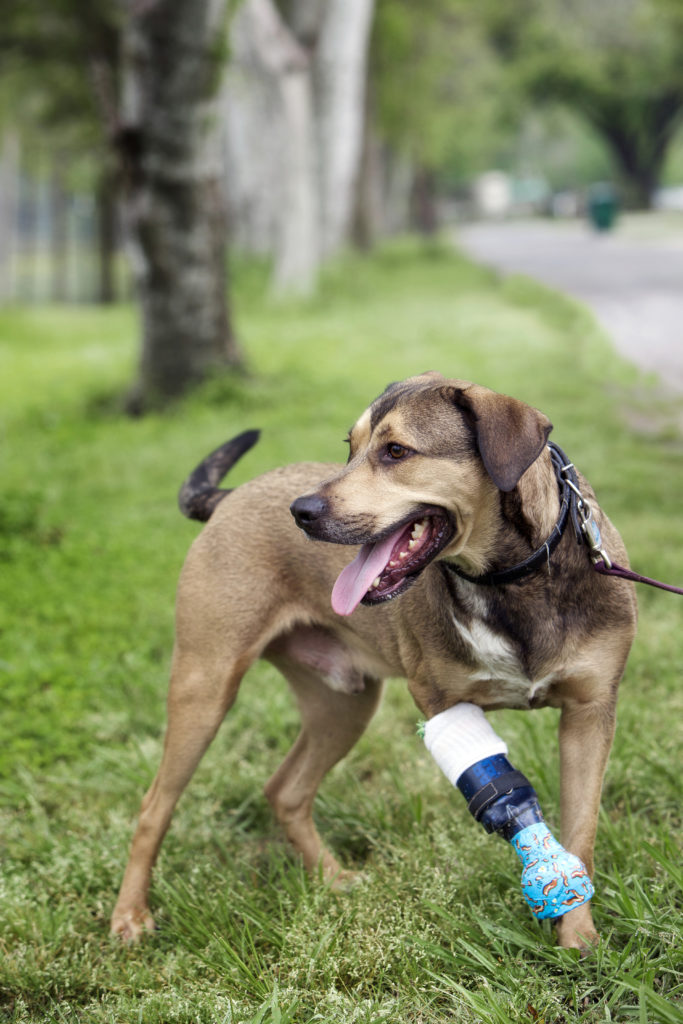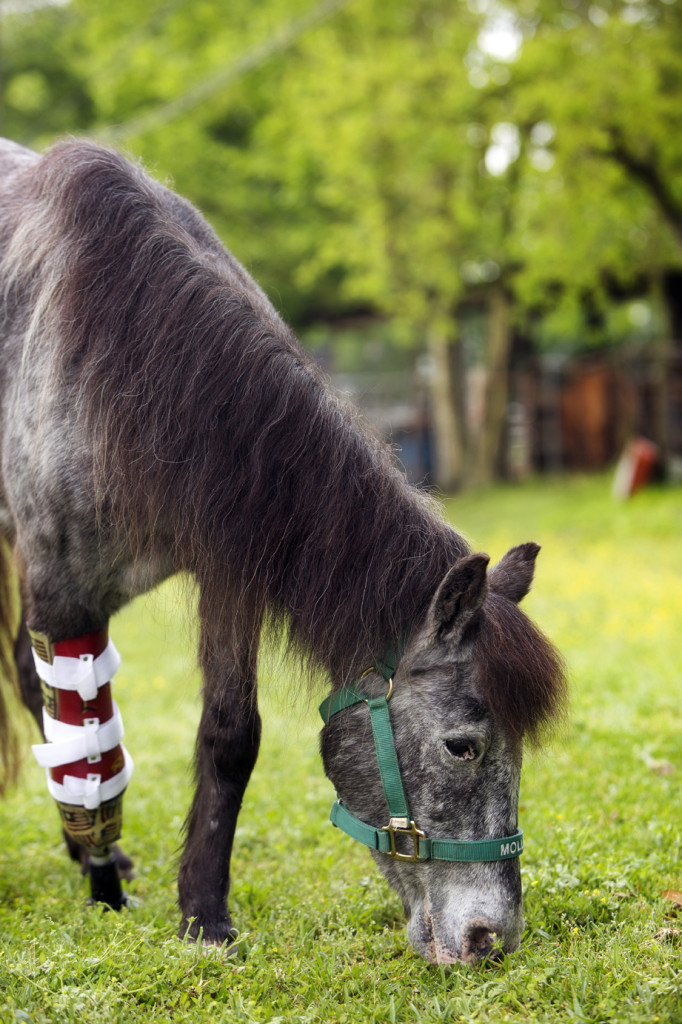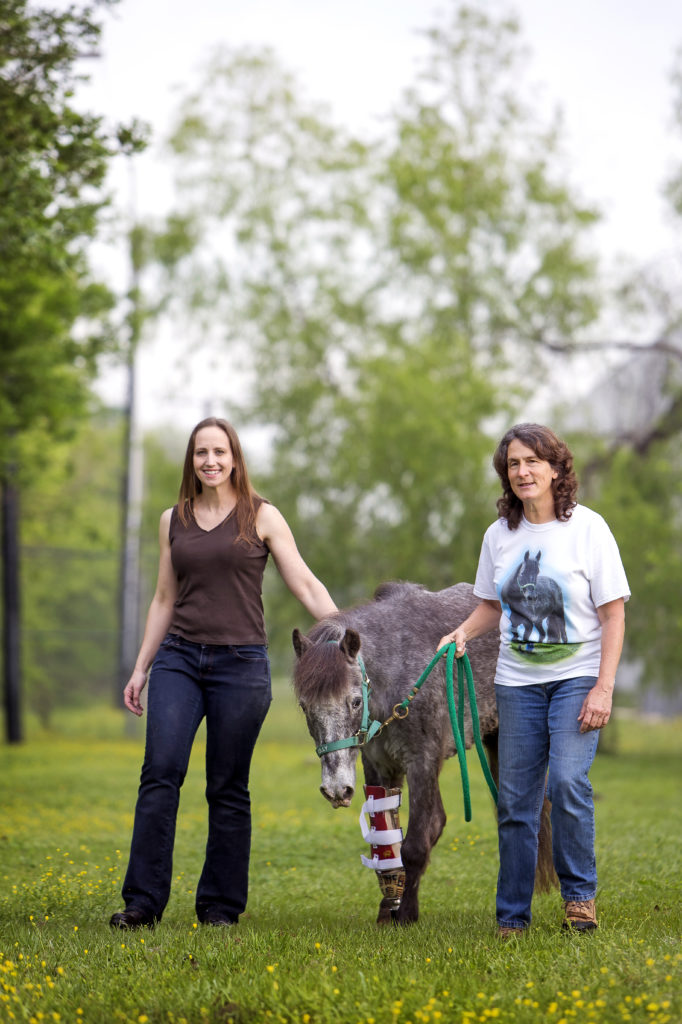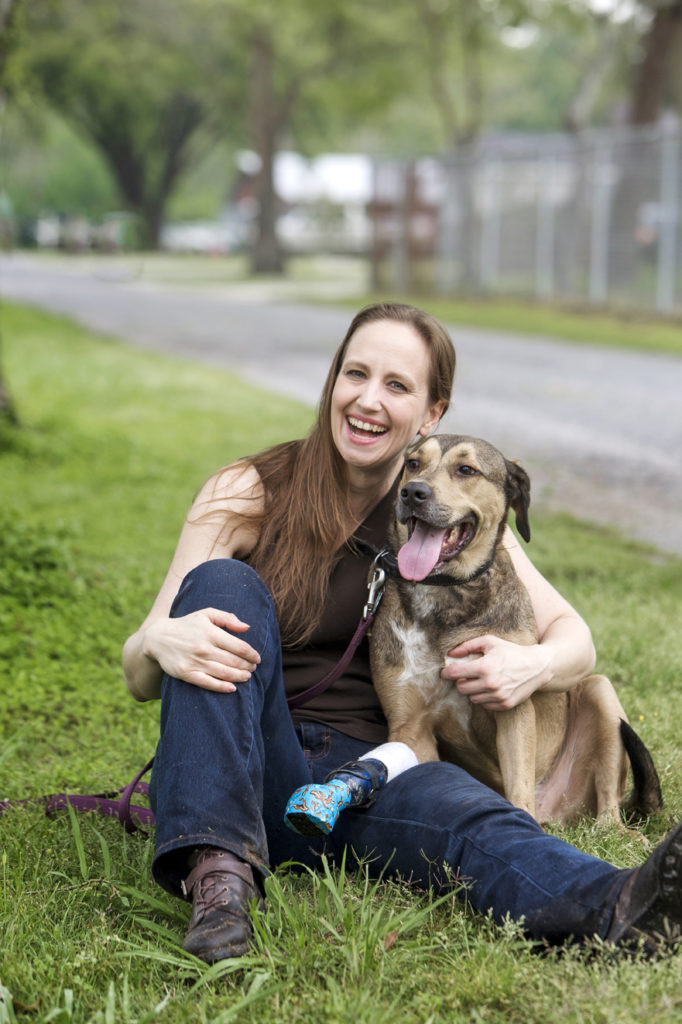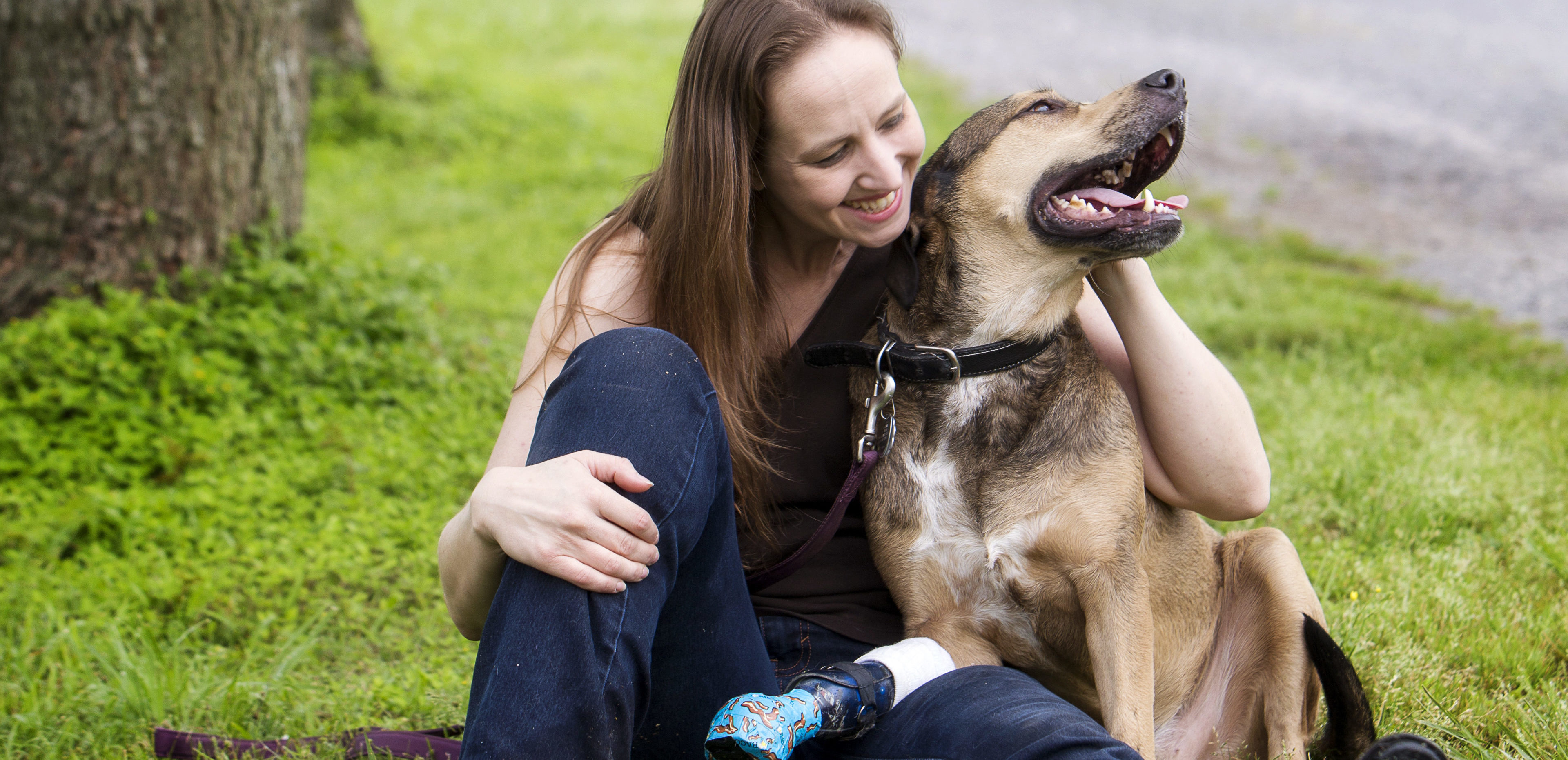
Happy feet
Niki Marie Hansen has devoted her life to creating prosthetic limbs for animals who might otherwise not survive
Every day, a 1,000-pound quarter horse strolled through the green acres of a Wisconsin farm with a girl sitting on his back.
The horse was named Power, and 8-year-old Niki Marie Hansen would pet his brown mane, saddle him up and lay her head on his hindquarters, before the pair rode off on another adventure.
Power was a surprise gift for her eighth birthday. To this day, Hansen calls his arrival one of the greatest moments of her life.
|
|
“When I saw that trailer come down the driveway,” Hansen says, holding back tears, “I just lost my mind. I don’t know if there has been a moment that’s ever topped that. Man, I loved that horse. He was my best friend.”
She was 12 when Power came up lame, a common veterinary problem in which a horse develops a mild to severe loss in its ability to move normally.
Equine lameness ranges from a subtle change in gait to the horse being unable to carry any weight on the affected limb. Lameness can be the result of leg breaks and soft tissue injuries such as mildly to severely torn tendons and chipped bones. Lameness is also one of the most common reasons for horses to be euthanized because of the many complications involved with treatment and the great diminishment in their quality of life.
After being told her beloved horse would likely need to be put down, Hansen was inconsolable. She began questioning everything.
“I wondered, ‘Why can’t he have a fake leg like people do?’” Hansen says. “‘Why does he have to die?’”
Power survived after risky surgery, but the experience started a fire in Hansen that would follow her for years.
After first going to college and receiving a degree in music, Hansen was still searching for a greater purpose. She was shuffling through jobs and struggling. Eventually, she wound up homeless, sleeping in her car and on friends’ couches for almost two months until she could find an apartment that accepted both her and the dog she had at the time.
“I was pleading with God to let me have some sort of meaning in my life,” Hansen says.
She thought back to Power and the questions she asked as a child. A friend of hers had recently forwarded her an article about a pony named Molly who had a prosthetic leg. Hansen was inspired. She had finally figured out what she wanted to do: become a veterinary prosthetist.
Hansen, now 37, has done just that. She’s been studying at the LSU School of Veterinary Medicine since 2009, currently finishing her doctoral degree. She earned her certification in human prosthetics at the Prosthetics and Orthotics Center at Northwestern University’s Feinberg School of Medicine in Chicago in 2012, the same year she crafted her first successful prosthetic leg for a friend’s goat named Padmé.
All that schooling allows her to follow through with her life’s work in the incredibly niche field of veterinary prosthetics. She now runs her own veterinary prosthetics business, Impossible Innovations Veterinary Prosthetics, in which she mainly crafts socket prosthetic limbs for animals small, medium and large. The process of fabricating a prosthesis for an animal is complex, and it can sometimes take Hansen months to craft one.
She’s successfully created custom socket prosthetic limbs, which go over the skin, for nearly a dozen animals. She’s spent thousands of her own money buying tools, supplies and materials to create them, and she charges owners next to nothing for them.
In deciding whether to make a prosthesis for an animal, Hansen takes into account temperament and need. Some smaller animals get along just fine on three legs.
A prosthesis also requires daily care. So if an owner lives an hour away from a horse, for instance, he or she has to be willing to sacrifice the costs of gas, extra veterinary care and unforeseen emergencies.
“The wound needs to be cleaned, cared for and monitored,” she says. “It’s going to take someone who is overly, insanely dedicated.”
Hansen found that insane dedication in Kaye Harris.
Harris, 54, and her husband, Glenn, 59, run Pony Tales in St. Rose. The business provides ponies for parties and wagon rides, as well as riding lessons and camps.
The two are also the owners of Molly, the pony whose story inspired Hansen years ago. Back then, Hansen never envisioned that Molly would become the first horse she’d make a prosthetic leg for.
For Harris, Molly isn’t just a farm animal. She’s a miracle horse with whom Harris has the deepest of personal connections. Harris and Molly check every box on Hansen’s animal-owner relationship list.
“She doesn’t own Molly; Molly owns her,” Hansen says.
The 400-pound blue roan pony is something of a New Orleans legend. After Hurricane Katrina, Harris and her husband rescued people and abandoned animals. They brought the animals back to their greater New Orleans farmland. Harris found Molly on Sept. 6, 2005, her 44th birthday.
“I want to protect these animals.”
—Niki Marie Hansen
She also found a pitbull whom she believes may have been a hunting dog. One day, she decided to leave the dog out with the rest of her animals, hoping that socializing with them would quell his constant escape attempts.
After going out that day, Harris returned home just in time to find the pitbull attacking Molly. He had ravaged all four of her legs and her jaw. Harris says if she arrived seconds later, Molly probably wouldn’t be alive today.
“I can see that Molly’s in shreds,” Harris remembers. “I’m sitting there with my hands all over this pony, trying to stop the bleeding.”
Molly survived, but while her other legs healed, her front right leg had no circulation and was too severely damaged for her to use. Harris recalls hearing and feeling a horrendous snap while doing recovery therapy with Molly one day. Molly’s hoof bone had fractured.
“She reared up in so much pain, and if she would have come down on me, she would’ve hurt me badly,” Harris says. “But this is how special she is—she rotated and came down next to me so she wouldn’t hit me. Even in the midst of her pain. This is what makes Molly who she is.”
Harris remembered the old adage “lose a limb, lose the horse.” She was determined not to let this become Molly’s fate.
At first, Harris’ vet thought she was crazy for suggesting Molly get her leg amputated and fit for a prosthesis. Like some, the vet thought it was unfair to put a horse through such an ordeal. The other vets Harris consulted said it would perhaps be better to put Molly down.
But Harris wasn’t willing to let Molly go—not because she was selfish, but because she had seen Molly survive a brutal attack. She had seen Molly get around on three legs. She believed in Molly’s incredible strength.
The amputation was completed at LSU’s Vet School, and Molly later received a prosthetic leg.
Upon enrolling at LSU, Hansen didn’t realize that Molly was close by in New Orleans. Even after she moved to Baton Rouge, it was years before she thought to reach out to Harris. Then, a mutual friend connected them and Hansen discovered Molly needed a new prosthesis, which she was able to create in 2014.
Hansen says she never imagined she’d be able to make a prosthesis for Molly. Getting to know the pony has enriched her life.
“She is like a person,” Hansen says. “Her eyes are just so telling and she senses everything. She knows if you’re there to help her, and she knows if you’re there to hurt her. I love that about Molly.”
The prosthetics process can be a never-ending rollercoaster. The pony was supported well on the prosthesis Hansen created for her at first, but over time, that changed. Currently she’s rejecting both Hansen’s leg and her older prosthesis, refusing to wear them for long periods of time.
Harris has to rotate through them each week trying to find the best one for Molly on a given day. Because of this, Hansen is building a new leg in an attempt to solve Molly’s discomfort. Harris is also seeking donations for advanced veterinary care.
“It’s not a ‘put it on and it’s happily ever after’ thing,” Harris says. “[Hansen’s] done everything with me to try and make the leg work for her.”
Still, there’s no doubt in Harris’ mind that these prostheses have saved Molly’s life.
Hansen says there are currently only about 20 to 40 horses and ponies in the country that have prosthetic limbs. Molly is the only one she knows of in Louisiana.
“What I’m doing for Molly, because she’s special to me, I’m not charging for that,” Hansen says. “That’s a labor of love. I love what I do so passionately that I’d do it without getting paid. If you can’t love something that much, you shouldn’t do it.”
That labor of love also extends to Hansen’s own pets.
About two years ago, Hansen’s friend, a shelter director in Iberville, asked her to help with Bob, a brown hound mix with damaged paws. His front right paw was stuck in a bent position—possibly from getting caught in a fence or hit by a car. The director didn’t think she could prevent the dog from being euthanized, so Hansen immediately agreed to help.
The dog had severe nerve damage, so Hansen decided the best treatment was amputation and then a prosthesis. After the amputation, Bob was bothered, perhaps by phantom pain or itching in the remaining part of his amputated limb, and he chewed it.
Bob had torn apart his soft tissue and ruined his wound closure. It took him almost a year to heal. His foster parent at the time couldn’t deal with the situation. So Bob came to Hansen, and she realized at that point Bob wasn’t just her patient. He was her dog.
“What’re you doing, bubba?” Hansen asks a tail-wagging Bob today. She laughs as he jumps into her lap in response. “You can’t not love him.”
These days, Hansen dubs Bob the happiest dog ever. He’s playful and kind, and a source of nonstop entertainment, as he crosses his paw with his prosthesis as if it were still his original limb. Passersby can’t help but stop and pet him.
Bob is comfortable with his current prosthesis, and Hansen says he can wear it for up to 24 hours. Of course, because of his old chewing habits, she had to make it as strong as possible.
“I could probably drive a car over this [prosthesis] and it wouldn’t break,” Hansen says. “Go ahead and try to chew that.”
Hansen is committed to spending the rest of her life saving animals like Molly and Bob. They are the embodiment of innocence, and for her, that innocence is one of the most precious things on the planet.
“When I’m working with Molly and Bob, time stands still,” Hansen says. “I wish I didn’t have to sleep, eat or go to the bathroom just so I could work. I don’t want jewelry for my birthday or Christmas, I want tools to make prosthetics with. I want to protect these animals.”
At 12 years old, saving her horse, Power, was Hansen’s sole priority. Twenty-five years later, she’s still just as devoted to saving animals and proving that loss of limb does not equal loss of life.
|
|
|
